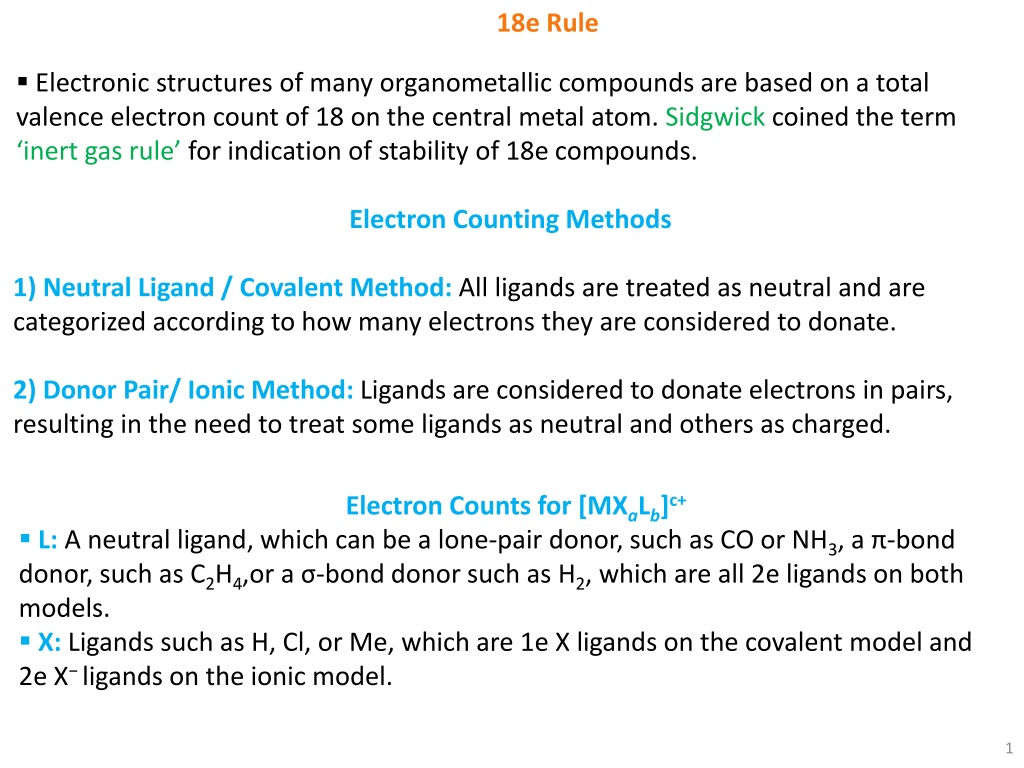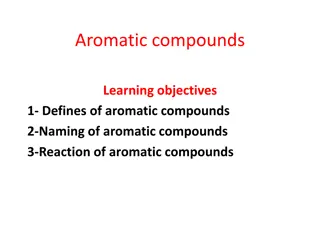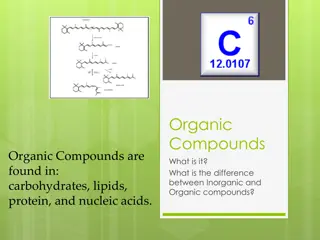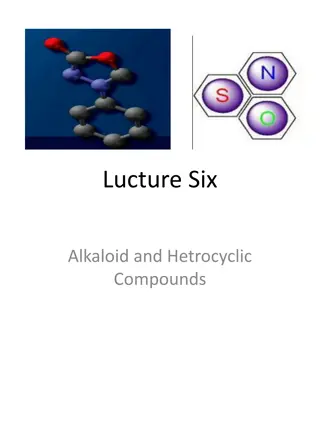Understanding the 18e Rule in Organometallic Compounds
The 18e rule dictates the electronic structures of many organometallic compounds, emphasizing a total valence electron count of 18 on the central metal atom for stability. Electron counting methods like the Covalent and Ionic models assist in determining the electron distribution among ligands. The rule's application to typical ligands and donor ligands is discussed, as well as the impact of metal carbonyls' structures on bonding modes. Both electron donation and acceptance influence the C-O bond strength in metal carbonyls.
Uploaded on Sep 24, 2024 | 0 Views
Download Presentation

Please find below an Image/Link to download the presentation.
The content on the website is provided AS IS for your information and personal use only. It may not be sold, licensed, or shared on other websites without obtaining consent from the author. Download presentation by click this link. If you encounter any issues during the download, it is possible that the publisher has removed the file from their server.
E N D
Presentation Transcript
18e Rule Electronic structures of many organometallic compounds are based on a total valence electron count of 18 on the central metal atom. Sidgwick coined the term inert gas rule for indication of stability of 18e compounds. Electron Counting Methods 1)Neutral Ligand / Covalent Method: All ligands are treated as neutral and are categorized according to how many electrons they are considered to donate. 2)Donor Pair/ Ionic Method: Ligands are considered to donate electrons in pairs, resulting in the need to treat some ligands as neutral and others as charged. Electron Counts for [MXaLb]c+ L: A neutral ligand, which can be a lone-pair donor, such as CO or NH3, a -bond donor, such as C2H4,or a -bond donor such as H2, which are all 2e ligands on both models. X: Ligands such as H, Cl, or Me, which are 1e X ligands on the covalent model and 2e X ligands on the ionic model. 1
18e Rule N: Number of electrons in neutral M atom. a and b are the numbers of ligands. c is the net ionic charge. Covalent Model Number of electrons on metal = N Number of electrons in ligands = a + 2b Total electron count = (N) + (a + 2b) c Ionic Model Oxidation state of metal ion = (c + a) Number of electrons on metal = N a c Number of electrons in ligands = 2a + 2b Total electron count = (N a c) + (2a + 2b) = N + a + 2b c 2
Electron Counts for Typical Ligands Ligand Covalent Ionic Ligand Covalent Ionic CO, PR3 H2O, NH3 H 2 2 H2 N2 R (alkyl, aryl) 1 2 2 2 2 2 2 1 2 2 Cl 1 2 4 4 2 2 5 6 H2C CH2 2 or 4 2 or 4 6 6 R R 3 4 3 2 1 2 In the covalent method, the linear NO is a 3e donor due to one and one bond, whereas bent NO is a 1e donor due to one single covalent bond. 3
Electron Counts for -Donor Ligands Ligand Covalent Ionic Ligand Covalent Ionic 2 2 6 6 H2C CH2 2 6 3 4 6 6 3 6 4 4 7 6 4 7 4 4 4 4 4 4 4 4 4 4 4 4 5 6 6 6 5 6 5 6 5 4
Structures of Metal Carbonyls Bonding Modes Bonding Scheme -bonding M dx2-y2 -bonding dxy M 5
Structures of Metal Carbonyls Bridging Modes of CO 6
Structures of Metal Carbonyls Both donation (which donates electron density from a bonding orbital on CO) and acceptance (which places electron density in C-O antibonding orbitals) would be expected to weaken the C-O bond and to decrease the energy necessary to stretch that bond. The more negative the charge on the organometallic species, the greater the tendency of the metal to donate electrons to the * orbitals of CO and the lower the energy of the C-O stretching vibrations. Order of C-O bond length: Ti(CO)62- > V(CO)6- > Cr(CO)6 > Mn(CO)6+ > Fe(CO)62+ 7
Structures of Simple Metal Carbonyls The carbonyls of the Period 4 elements of Groups 6 to 10 obey the 18-electron rule; they have alternately one and two metal atoms and a decreasing number of CO ligands. 10 8























